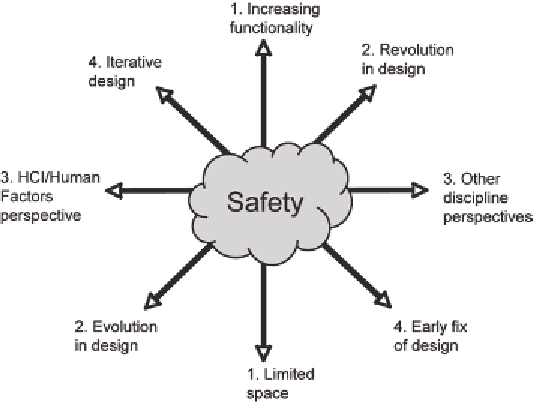Information Technology Reference
In-Depth Information
this point eloquently when he notes that he “knows
of no-one who has ever been killed as a conse-
quence of operating a computer at a desk, but the
loss of life associated with crashes arising from
normal motor vehicle operation is huge” (Green,
2008, p.702). Every year, approximately 1.2 mil-
lion people die in road traffic collisions (WHO,
2004), and, in the vast majority of cases human
error is the primary contributing factor (Dewar
and Olson, 2002).
In some respects, safety can be seen as a cloud
(or mist) that hangs over the automobile industry
and impacts on many design decisions. Figure 1
illustrates a range of tensions which exist within
the design process for in-car computing. These
have been informed by my experience of working
closely with vehicle designers and engineers. They
are also influenced by recent work we conducted
at Nottingham in which ten industry experts were
interviewed regarding their perspectives on HCI
and Human Factors research and the develop-
ment of in-car computing systems (Irune and
Burnett, 2008). Whilst several other tensions will
inevitably arise (e.g. cost versus functionality), I
believe these particular tensions to be specific to
in-car computing and HCI issues. Importantly,
HCI research must recognise such tensions in
their development of methods, tools and interface
solutions.
•
Tension 1:
A contextual factor of consider-
able importance for in-car computing is
space. A vehicle has limited 'real estate'
and drivers/passengers must sit in relative-
ly constrained postures, often for consider-
able periods of time. Pressures act to in-
crease functionality within the vehicle, yet
the space available for controls and dis-
plays does not generally change. This fac-
tor has had a considerable impact on the
nature of user-interfaces developed for ve-
hicles, in particular, the current trend for
menu-based interfaces, together with
touchscreen or rotary controller input
devices.
•
Tension 2:
Designers often seek innova-
tion in their work. However, the automo-
bile industry can be particularly conser-
vative, such that there is often a focus on
evolution, rather than revolution, in design.
Novel designs are developed, but these
Figure 1. Typical tensions existing in the design process for in-car computing systems

Search WWH ::

Custom Search